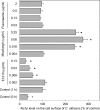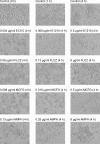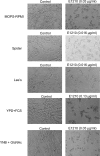E1210, a new broad-spectrum antifungal, suppresses Candida albicans hyphal growth through inhibition of glycosylphosphatidylinositol biosynthesis
- PMID: 22143530
- PMCID: PMC3264227
- DOI: 10.1128/AAC.00731-11
E1210, a new broad-spectrum antifungal, suppresses Candida albicans hyphal growth through inhibition of glycosylphosphatidylinositol biosynthesis
Abstract
Continued research toward the development of new antifungals that act via inhibition of glycosylphosphatidylinositol (GPI) biosynthesis led to the design of E1210. In this study, we assessed the selectivity of the inhibitory activity of E1210 against Candida albicans GWT1 (Orf19.6884) protein, Aspergillus fumigatus GWT1 (AFUA_1G14870) protein, and human PIG-W protein, which can catalyze the inositol acylation of GPI early in the GPI biosynthesis pathway, and then we assessed the effects of E1210 on key C. albicans virulence factors. E1210 inhibited the inositol acylation activity of C. albicans Gwt1p and A. fumigatus Gwt1p with 50% inhibitory concentrations (IC(50)s) of 0.3 to 0.6 μM but had no inhibitory activity against human Pig-Wp even at concentrations as high as 100 μM. To confirm the inhibition of fungal GPI biosynthesis, expression of ALS1 protein, a GPI-anchored protein, on the surfaces of C. albicans cells treated with E1210 was studied and shown to be significantly lower than that on untreated cells. However, the ALS1 protein levels in the crude extract and the RHO1 protein levels on the cell surface were found to be almost the same. Furthermore, E1210 inhibited germ tube formation, adherence to polystyrene surfaces, and biofilm formation of C. albicans at concentrations above its MIC. These results suggested that E1210 selectively inhibited inositol acylation of fungus-specific GPI which would be catalyzed by Gwt1p, leading to the inhibition of GPI-anchored protein maturation, and also that E1210 suppressed the expression of some important virulence factors of C. albicans, through its GPI biosynthesis inhibition.
Figures












Similar articles
-
Activities of E1210 and comparator agents tested by CLSI and EUCAST broth microdilution methods against Fusarium and Scedosporium species identified using molecular methods.Antimicrob Agents Chemother. 2012 Jan;56(1):352-7. doi: 10.1128/AAC.05414-11. Epub 2011 Nov 14. Antimicrob Agents Chemother. 2012. PMID: 22083469 Free PMC article.
-
Efficacy of oral E1210, a new broad-spectrum antifungal with a novel mechanism of action, in murine models of candidiasis, aspergillosis, and fusariosis.Antimicrob Agents Chemother. 2011 Oct;55(10):4543-51. doi: 10.1128/AAC.00366-11. Epub 2011 Jul 25. Antimicrob Agents Chemother. 2011. PMID: 21788462 Free PMC article.
-
Evaluation of Resistance Development to the Gwt1 Inhibitor Manogepix (APX001A) in Candida Species.Antimicrob Agents Chemother. 2019 Dec 20;64(1):e01387-19. doi: 10.1128/AAC.01387-19. Print 2019 Dec 20. Antimicrob Agents Chemother. 2019. PMID: 31611349 Free PMC article.
-
Targeting the GPI biosynthetic pathway.Pathog Glob Health. 2018 May;112(3):115-122. doi: 10.1080/20477724.2018.1442764. Epub 2018 Feb 27. Pathog Glob Health. 2018. PMID: 29484956 Free PMC article. Review.
-
Generating anchors only to lose them: The unusual story of glycosylphosphatidylinositol anchor biosynthesis and remodeling in yeast and fungi.IUBMB Life. 2018 May;70(5):355-383. doi: 10.1002/iub.1734. IUBMB Life. 2018. PMID: 29679465 Review.
Cited by
-
In Vitro Activity of Manogepix against Multidrug-Resistant and Panresistant Candida auris from the New York Outbreak.Antimicrob Agents Chemother. 2020 Oct 20;64(11):e01124-20. doi: 10.1128/AAC.01124-20. Print 2020 Oct 20. Antimicrob Agents Chemother. 2020. PMID: 32839219 Free PMC article.
-
Molecular basis of the inositol deacylase PGAP1 involved in quality control of GPI-AP biogenesis.Nat Commun. 2024 Jan 2;15(1):8. doi: 10.1038/s41467-023-44568-2. Nat Commun. 2024. PMID: 38167496 Free PMC article.
-
In Vitro Activity of APX001A (Manogepix) and Comparator Agents against 1,706 Fungal Isolates Collected during an International Surveillance Program in 2017.Antimicrob Agents Chemother. 2019 Jul 25;63(8):e00840-19. doi: 10.1128/AAC.00840-19. Print 2019 Aug. Antimicrob Agents Chemother. 2019. PMID: 31182527 Free PMC article.
-
Molecular association of Candida albicans and vulvovaginal candidiasis: focusing on a solution.Front Cell Infect Microbiol. 2023 Oct 13;13:1245808. doi: 10.3389/fcimb.2023.1245808. eCollection 2023. Front Cell Infect Microbiol. 2023. PMID: 37900321 Free PMC article. Review.
-
An Overview of Diagnostic and Management Strategies for Talaromycosis, an Underrated Disease.J Fungi (Basel). 2023 Jun 6;9(6):647. doi: 10.3390/jof9060647. J Fungi (Basel). 2023. PMID: 37367583 Free PMC article. Review.
References
-
- Abe S, Satoh T, Tokuda Y, Tansho S, Yamaguchi H. 1994. A rapid colorimetric assay for determination of leukocyte-mediated inhibition of mycelial growth of Candida albicans. Microbiol. Immunol. 38: 385–388 - PubMed
-
- Albrecht A, et al. 2006. Glycosylphosphatidylinositol-anchored proteases of Candida albicans target proteins necessary for both cellular processes and host-pathogen interactions. J. Biol. Chem. 281: 688–694 - PubMed
MeSH terms
Substances
LinkOut - more resources
Full Text Sources
Other Literature Sources
Molecular Biology Databases

